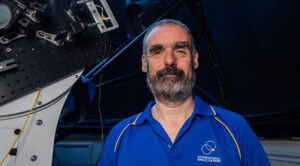Space enthusiasts and astronomers at The University of Western Australia’s International Space Centre have celebrated the first images from NASA’s $14 billion James Webb Space Telescope’s history making view of space.
The UWA Centre was one of only a handful of institutions in the world to get the first working images from the most powerful orbiting telescope. The James Webb Space Telescope is more than double the size of Hubble and can deliver clearer views of galaxies and planets forming.
UWA Astronomy Professor Simon Driver said they had no idea what the First Light images would be but they did know the telescope had already observed many of the team’s target fields.
“It is fantastic to be part of this and to know UWA students were among the first in the world to work on the telescope’s data,” Professor Driver said.

UWA Astronomy Professor Simon Driver
The James Webb Space Telescope was designed to probe the mysterious structures and origins of the universe and our place in it by detecting infra-red and mid-infrared wavelengths.
As part of an 80-person international team, Professor Driver said there had been a ‘frenzy of online meetings’ to prepare codes and strategies for processing the data from space.
“UWA’s key focus is to find the very first photons, minted by the very first stars, which have been travelling for over 13 billion years before hitting the telescope’s mirror and forming an image for us to study,” he said.
On Tuesday, NASA crossed live to the International Space Centre during a global press conference. Just as an Australian ground station was vital to the Apollo 11 mission, as popularised in the film The Dish, the ground station at Tidbinbilla near Canberra played a crucial role in the mission.
“Because the Earth rotates, the only way to have continuous communications is with a network of deep space tracking stations distributed around the world which is why both NASA and the European Space Agency operate communications stations in Australia,” Professor Driver said.
“Any time it is dark in Australia, the NASA Jet Propulsion Laboratory station at Tidbinbilla was downloading data to transfer to the US and uploading commands to and from the telescope.
“UWA contributed to the background analysis, source detection and the measurement of the extragalactic background light for these first images.”